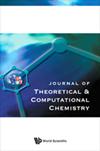Benchmark study of the linear and nonlinear optical polarizabilities in proto-type NLO molecule of para-nitroaniline
IF 2.4
Q3 Computer Science
Journal of Theoretical & Computational Chemistry
Pub Date : 2019-11-04
DOI:10.1142/s0219633619500305
引用次数: 48
Abstract
In the present investigation, for the first time, we have performed a thorough study about different functionals and basis sets for linear and nonlinear optical (NLO) properties of para-nitroaniline ([Formula: see text]-NA), which is considered as proto-type NLO molecule, among organic NLO materials. There is a dire need of such data base for [Formula: see text]-NA because many investigators are using such values of [Formula: see text]-NA for comparative analysis. A range of different functionals including HF, BLYP, PW91, PBE, B3LYP, M06, M06-2X, PBE0, BHandHLYP, CAM-B3LYP, LC-BLYP, and B3LYP-D3 are applied in conjugation with several commonly basis sets such as 6-31G*, 6-311G*, 6-311G**, 6-311+G**, cc-pVDZ, and cc-pVTZ. A variety of functional and basis sets combinations are calculated and graphically compared with each other. The calculated total dipole moment for the [Formula: see text]-NA is found to be 6.79[Formula: see text]D which is quite closer to experimentally determined value. The lowest calculated value for linear isotropic polarizability at HF/6-31G* level of theory is [Formula: see text] esu while higher values observed with remaining all methods especially 14% polarizability increases in presence of basis set with diffuse functions and similar trend of variation is also observed in linear anisotropic polarizability. Similarly, the calculated value of frequency dependent second-order polarizability is found to be [Formula: see text] esu at PBE0/6-311+G** level of theory which is quite closer to experimental value of [Formula: see text] esu. A comparison between the calculated and experimental results shows good agreement among geometries, dipole moments and NLO polarizabilities for [Formula: see text]-NA. Moreover, the frontier molecular orbital (FMO) and electron density difference map (EDDM) analysis along with density of state (DOS) plots are also presented to get more physical intuitions into the structure–property relationship and electronic communications between terminal accepter and donor groups through [Formula: see text]-conjugation. The present investigation provides benchmark data including various commonly used functionals and basis sets for the calculation of NLO properties of [Formula: see text]-NA. Thus, the present investigation will put straight several future studies when it comes to comparative NLO study of organic materials.对硝基苯胺NLO原型分子线性和非线性光学极化率的基准研究
在本研究中,我们首次对有机非线性光学材料中被认为是原型非线性光学分子的对硝基苯胺([式:见正文]-NA)的线性和非线性光学(NLO)性质的不同泛函和基集进行了深入的研究。由于许多研究人员正在使用[公式:见正文]-NA的此类值进行比较分析,因此迫切需要此类[公式:见正文]-NA数据库。一系列不同的泛函,包括HF、BLYP、PW91、PBE、B3LYP、M06、M06-2X、PBE0、BHandHLYP、CAM-B3LYP、LC-BLYP和B3LYP-D3,与几个常见的基集结合使用,如6-31G*、6-311G*、6-311 G**、6-311+G**、cc-pVDZ和cc-pVTZ。对各种函数集和基集的组合进行了计算,并以图形方式相互比较。[公式:见正文]-NA的计算总偶极矩为6.79[公式:参见正文]D,这与实验确定的值非常接近。在HF/6-31G*理论水平下,线性各向同性极化率的最低计算值为[公式:见正文]esu,而在剩余的所有方法中观察到的值更高,尤其是在存在具有扩散函数的基集的情况下,14%的极化率增加,并且在线性各向异性极化率中也观察到类似的变化趋势。同样,在理论PBE0/6-311+G**水平上,频率相关二阶极化率的计算值为[公式:见正文]esu,与[公式:参见正文]esu的实验值非常接近。计算结果与实验结果的比较表明,[公式:见正文]-NA的几何结构、偶极矩和NLO极化率之间存在良好的一致性。此外,还提出了前沿分子轨道(FMO)和电子密度差图(EDDM)分析以及态密度(DOS)图,以通过[公式:见正文]-共轭对末端受体和供体基团之间的结构-性质关系和电子通信有更多的物理直观性。本研究提供了包括各种常用泛函和基集的基准数据,用于计算[公式:见正文]-NA的NLO性质。因此,当涉及到有机材料的NLO比较研究时,本研究将为未来的几项研究指明方向。
本文章由计算机程序翻译,如有差异,请以英文原文为准。
求助全文
约1分钟内获得全文
求助全文
来源期刊
CiteScore
1.70
自引率
0.00%
发文量
0
审稿时长
3 months
期刊介绍:
The Journal of Theoretical and Computational Chemistry (JTCC) is an international interdisciplinary journal aimed at providing comprehensive coverage on the latest developments and applications of research in the ever-expanding field of theoretical and computational chemistry.
JTCC publishes regular articles and reviews on new methodology, software, web server and database developments. The applications of existing theoretical and computational methods which produce significant new insights into important problems are also welcomed. Papers reporting joint computational and experimental investigations are encouraged. The journal will not consider manuscripts reporting straightforward calculations of the properties of molecules with existing software packages without addressing a significant scientific problem.
Areas covered by the journal include molecular dynamics, computer-aided molecular design, modeling effects of mutation on stability and dynamics of macromolecules, quantum mechanics, statistical mechanics and other related topics.

 求助内容:
求助内容: 应助结果提醒方式:
应助结果提醒方式:


